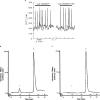Evidence that 2-methylthioATP and 2-methylthioADP are both agonists at the rat hepatocyte P2Y(1) receptor
- PMID: 10821796
- PMCID: PMC1572108
- DOI: 10.1038/sj.bjp.0703350
Evidence that 2-methylthioATP and 2-methylthioADP are both agonists at the rat hepatocyte P2Y(1) receptor
Abstract
In the absence of selective antagonists, pharmacological characterization of P2Y receptor subtypes has relied heavily upon their distinct agonist profiles. 2-methylthioADP (2-MeSADP) is a selective agonist for the P2Y(1) receptor. The agonist action of 2-MeSATP at the P2Y(1) receptor has recently been questioned. The effects of both 2-MeSADP and 2-MeSATP have been studied on rat hepatocytes injected with the bioluminescent Ca(2+) indicator, aequorin. Single hepatocytes generate series of repetitive transients in cytosolic free calcium concentration ([Ca(2+)](i)) when stimulated with agonists acting through the phosphoinositide signalling pathway. The transients induced by 2-MeSADP and 2-MeSATP in the same cell were indistinguishable, indicating that they act at a common receptor. In contrast the transients evoked by ATP and UTP had very different profiles. Treatment of 2-MeSATP with an ATP-regenerating system to remove contaminating 2-MeSADP did not abolish its agonist activity. Application of the P2Y(1) antagonist, adenosine-3'-phosphate-5'-phosphate (A3P5P) inhibited the transients induced by both 2-MeSADP and 2-MeSATP. In contrast the transients induced by ATP and UTP were enhanced by the addition of A3P5P. These results indicate that both 2-MeSADP and 2-MeSATP are agonists at the rat hepatocyte P2Y(1) receptor.
Figures




Similar articles
-
Actions of ADP, but not ATP, on cytosolic free Ca2+ in single rat hepatocytes mimicked by 2-methylthioATP.Br J Pharmacol. 1995 Oct;116(3):1979-84. doi: 10.1111/j.1476-5381.1995.tb16401.x. Br J Pharmacol. 1995. PMID: 8640335 Free PMC article.
-
Evidence that rat hepatocytes co-express functional P2Y1 and P2Y2 receptors.Br J Pharmacol. 2000 Feb;129(4):764-70. doi: 10.1038/sj.bjp.0703103. Br J Pharmacol. 2000. PMID: 10683201 Free PMC article.
-
Regulation of rat hepatocyte function by P2Y receptors: focus on control of glycogen phosphorylase and cyclic AMP by 2-methylthioadenosine 5'-diphosphate.J Pharmacol Exp Ther. 2004 Oct;311(1):334-41. doi: 10.1124/jpet.104.067744. Epub 2004 May 19. J Pharmacol Exp Ther. 2004. PMID: 15152027
-
Further subclassification of ATP receptors based on agonist studies.Trends Pharmacol Sci. 1991 Apr;12(4):137-41. doi: 10.1016/0165-6147(91)90530-6. Trends Pharmacol Sci. 1991. PMID: 2063479 Review.
-
The complex interaction of ATP and UTP with isolated hepatocytes. How many receptors?Gen Pharmacol. 1993 Mar;24(2):283-9. doi: 10.1016/0306-3623(93)90304-g. Gen Pharmacol. 1993. PMID: 8482512 Review.
Cited by
-
P2Y receptor regulation of cultured rat cerebral cortical cells: calcium responses and mRNA expression in neurons and glia.Br J Pharmacol. 2003 May;139(2):279-88. doi: 10.1038/sj.bjp.0705242. Br J Pharmacol. 2003. PMID: 12770933 Free PMC article.
-
Important roles of P2Y receptors in the inflammation and cancer of digestive system.Oncotarget. 2016 May 10;7(19):28736-47. doi: 10.18632/oncotarget.7518. Oncotarget. 2016. PMID: 26908460 Free PMC article. Review.
-
Facilitation of transmitter release from rat sympathetic neurons via presynaptic P2Y(1) receptors.Br J Pharmacol. 2011 Nov;164(5):1522-33. doi: 10.1111/j.1476-5381.2011.01466.x. Br J Pharmacol. 2011. PMID: 21557728 Free PMC article.
-
The role of purinergic signaling in the liver and in transplantation: effects of extracellular nucleotides on hepatic graft vascular injury, rejection and metabolism.Front Biosci. 2008 Jan 1;13:2588-603. doi: 10.2741/2868. Front Biosci. 2008. PMID: 17981736 Free PMC article. Review.
-
P2Y(1) and P2Y(2) receptors are coupled to the NO/cGMP pathway to vasodilate the rat arterial mesenteric bed.Br J Pharmacol. 2002 Jul;136(6):847-56. doi: 10.1038/sj.bjp.0704789. Br J Pharmacol. 2002. PMID: 12110609 Free PMC article.
References
-
- BERRIDGE M.J. Calcium oscillations. J. Biol. Chem. 1990;265:9583–9586. - PubMed
-
- BOARDER M.R., HOURANI S.M.O. The regulation of vascular function by P2 receptors: multiple sites and multiple receptors. Trends Pharmacol. Sci. 1998;19:99–107. - PubMed
-
- BOYER J.L., ROMERO-AVILA T., SCHACHTER J.B., HARDEN T.K. Identification of competitive antagonists of the P2Y receptor. Mol. Pharmacol. 1996;50:1323–1329. - PubMed
-
- BURNSTOCK G.P2 purinoceptors: historical perspective and classification P2 purinoceptors: localization, function and transduction mechanisms 1996198Chichester: John Wiley & Sons Ltd; 1–29.Ciba Foundation Symposium - PubMed
-
- BURNSTOCK G., KING B.F. The numbering of cloned P2 receptors. Drug Dev. Res. 1996;38:67–71.
Publication types
MeSH terms
Substances
LinkOut - more resources
Full Text Sources
Other Literature Sources
Miscellaneous

